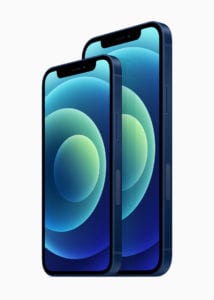“What all of the models have in common, besides their support for 5G connectivity, is their use of Face ID as the sole means of biometric authentication.”

Apple has officially unveiled the iPhone 12, its first 5G device – a little later than usual, presumably due to supply chain delays caused by the COVID-19 pandemic.
With that high-speed connectivity being the new smartphone’s key feature and selling point for distinguishing it from previous iPhone devices, the iPhone 12 is otherwise very much an iterative update, rather than any kind of substantial overhaul of the iPhone concept. It has a faster processor in the A14 Bionic chip, a “Ceramic Shield” casing that makes it more durable than its predecessors, and better imaging capabilities.
To be clear, there are four different variations of the iPhone 12 model, with some little differences between them. The standard-issue iPhone 12 features an “Advanced” dual-camera system, for example, whereas the larger iPhone 12 Pro has a “Pro” camera system featuring not just an Ultra Wide and a Wide Lens, but also a Telephoto lens. And unlike the iPhone 12, the iPhone 12 Pro features a LiDAR scanner to support Night mode imaging and Augmented Reality applications – as does the iPhone 12 Pro Max, which is distinguished by its 6.7″ display, as opposed to the Pro’s 6.1″ display.
Bigger isn’t necessarily better, of course. Apple also announced the iPhone Mini, a device with a 5.4″ display that Apple has billed as the the world’s “smallest, thinnest, lightest 5G phone.”
What all of the models have in common, besides their support for 5G connectivity, is their use of Face ID as the sole means of biometric authentication.
This is important. Apple shook up the mobile biometrics industry when it introduced its 3D facial recognition system in late 2017, and seemed to signal a permanent shift to the modality in subsequent devices that supported Face ID and lacked its predecessor, the Touch ID fingerprint scanning system. So it raised some eyebrows when the company launched the more budget-friendly iPhone SE this past spring, with that device pivoting back to Touch ID, and not supporting Face ID.
It appears that move was predicated on cost efficiency. Requiring special laser components, Face ID is reportedly a more expensive authentication system than Touch ID. And now that Apple has swung back to its flagship iPhone line, all of which are billed as premium devices, the company had no problem bringing back Face ID. Adding an in-display fingerprint scanner as another biometric option, however – as some of its rivals have done – was evidently not seen as worth the cost.
Pricing for the new iPhones starts at $699 for the iPhone Mini, up to $1099 for the iPhone Pro Max. The iPhone 12 and iPhone 12 Pro are scheduled to ship on October 16, while the Mini and Pro Max will come out on November 6.

Follow Us